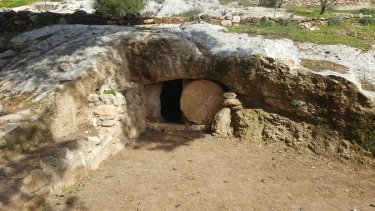Atheist's Attacks
Answering Humanist's Accusations Against the Bible


Who Got To Jesus' Tomb When?
Are there contradictions in the resurrection stories?
HUMANIST QUESTION: There are even contradictions in the accounts of the resurrection – the supposed event that is the very foundation of the Christian religion.

The Humanists follow the above accusation with three examples concerning the Sunday morning when the tomb was empty. I will answer them one at a time. Keep in mind there were a number of different people coming to and going from the tomb that morning. The empty tomb was shocking... unbelievable... There was a lot of confusion and people were running back and forth, to and from the empty tomb.
Mark 16:2 states that on the day of the resurrection, certain women arrived at the tomb at the rising of the sun. But John 20:1 informs us they arrived when it was yet dark.
Here is what scripture says in Mark 16:2 and John 20:1:
When the Sabbath was over, Mary Magdalene, and Mary the mother of James, and Salome, bought spices, so that they might come and anoint Him. Very early on the first day of the week, they came to the tomb when the sun had risen.
John, on the other hand, only mentions Mary and says that it was still dark.
Now on the first day of the week Mary Magdalene came early to the tomb, while it was still dark, and saw the stone already taken away from the tomb.
Who is right? Did they arrive at the tomb while it was still dark, or was it after the sun had risen?
Let's add some information not mentioned in the humanist’s question. Matthew and Luke also report that the women came to the tomb at dawn. Here is what Matthew wrote: (28:1) Now after the Sabbath, as it began to dawn toward the first day of the week, Mary Magdalene and the other Mary came to look at the grave.
What happened is that as dawn was just beginning Mary Mag-dalene got to the tomb before the other women. Most of the sky was still dark, but the eastern horizon was just starting to glow.
John, although writing in a simple style, tends to go deeper in how he describes events. In this case it is interesting that the Greek word used by John, and translated as "dark" (Strong's 4653) is also associated with the idea of unhappiness or ruin . As is typical of how John writes, in his choice of words he is describing more than just the sky. He is describing the mood of the women. The women, as well as the apostles, were in despair. They felt as though they had given up everything for a lie. The Messiah was dead. The woman did not yet know Jesus had risen, so their mood was still dark
Luke 24:2 describes the tomb as open when the women arrived, whereas Matthew 28:1-2 indicates it was closed. Here is what scripture says:
Luke 24:1-2 - But on the first day of the week, at early dawn, they came to the tomb bringing the spices which they had prepared. And they found the stone rolled away from the tomb...
Matthew 28:1-4 - Now after the Sabbath, as it began to dawn toward the first day of the week, Mary Magdalene and the other Mary came to look at the grave. And behold, a severe earthquake had occurred, for an angel of the Lord descended from heaven and came and rolled away the stone and sat upon it. And his appearance was like lightning, and his clothing as white as snow. The guards shook for fear of him and became like dead men.
Pay close attention to what Matthew wrote. He states that the women arrive at dawn, then he talks about the earthquake in the past tense. Matthew fills in the details that explain why the women found the grave open. They were surprised that the stone had been rolled away. They had not been expecting this. Mat-thew is not saying the tomb was closed, he is explaining how the heavy stone was moved (past tense).
Mark 16:5 declares that the women saw a young man at the tomb, Luke 24:4 says they saw two men, Matthew 28:2 reports they saw an angel, and John 20:11-12 claims they saw two angels.
The first question what do angels look like? The answer is, angels do not have a physical form, but they do have the ability to appear in human form. For more about the appearance of angels visit: www.gotquestions.org/angels-look.html
Here is a good question. If I said, "I saw a man wearing a white suit sitting on the park bench" does that mean he was the only man sitting on the bench? No. Does that mean there were no men stand-ing next to the park bench? No. All you know is that there was a man in a white suit sitting on the bench. There could have been oth-er people there.
As I have said before, be aware that each gospel writer addresses a different audience, and each may be answering different ques-tions. In this case Matthew and Mark are explaining how the stone was rolled away, and Luke and John are addressing the question of what happened to the body. As a result, the information they report has a different focus.
There are no contradictions here. There were two angels. That Mark and Luke refer to the angels as men is not a problem. That is what they looked like and scripture often identified angels as men (based on their appearance), such as in Genesis 18:1–2 and Daniel 9:21. In this case, Mark and Luke are reporting that the woman at first thought they were looking at men. My guess is that if an angel appeared to you right now, in the form of a man, your first thought would be that you were looking at a man. Your reaction would be, "Where did he come from?"
What did we find out here? There is no contradiction.
Next accusation...
Also in the resurrection stories, there are contradictions as to the identity of the women who came to the tomb, whether the men or angels the women saw were inside or outside the tomb, whether the men or angels were standing or sitting, and whether Mary Magdalene recognized the risen Jesus when he first appeared to her.
The answers to these are going to be very similar to what you just read, but click here and you can read the details.
< SORRY,
I NEVER KNEW YOU

Many people, when they die, will stand before Jesus and say:
Lord, Lord, did we not prophesy in Your name, and in Your name cast out demons, and in Your name perform many miracles? - Matthew 7:22
And Jesus will say to them:
I never knew you; depart from Me, you who practice lawlessness. - Matthew 7:23
Get your Bible out and read Matthew 7:21-23. These are some of the most frightening verses in the Bible.
They describe people who believe with all their heart that they are saved. They have no doubt that they know Jesus and they've done many great things that prove this is true. Put Jesus says, 'Depart from me...' He doesn't know them.
Are you truly trusting Jesus? Scripture says to examine yourself to see if you are in the faith (2 Corinthians 13:5). Have you done that?
Do you read your Bible regularly? Do you fear false teaching? Are you growing in your obedience to God? Are you growing in your understanding of what God wants? Do you regularly share the good news about Jesus with others?
